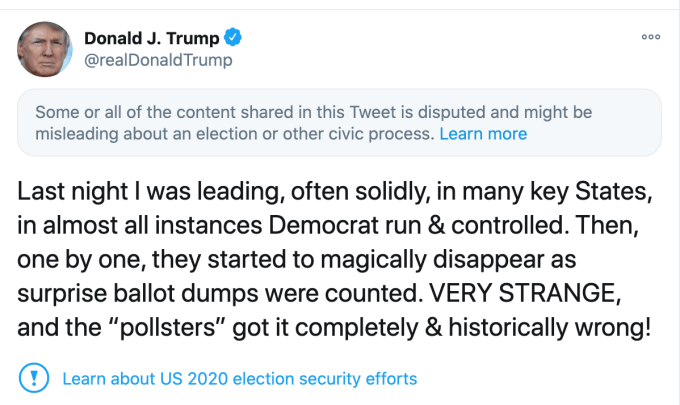When Trump spoke early Wednesday morning, it became clear which long-dreaded election scenario an anxious nation was on the cusp of.
“This is a fraud on the American public,” Trump said in remarks delivered from the White House, mixing his campaign with the presidency. “We were getting ready to win this election. Frankly, we did win this election.”
Trump’s claim of victory is false — votes are still being counted in a close race — but they heralded his campaign’s intention to work the misinformation ecosystem he’s cultivated over the last four years. His strategy so far is what he’s long signaled: seize on the late tallies for vote-by-mail ballots, which were expected to favor Democrats, to manufacture a conspiracy.
On Wednesday, Twitter hid three of Trump’s five recent tweets behind warning labels stating that their content was “disputed and might be misleading.” Most recently, the president tweeted “They are working hard to make up 500,000 vote advantage in Pennsylvania disappear — ASAP. Likewise, Michigan and others!”
In another recent missive, he circumvented a restricted tweet’s engagement limits, amplifying it to his own follower base where it was retweeted 32,000 times. The tweet’s author issued a correction on his original conspiratorial claims about Michigan’s Democratic vote count, but by then the horse had already left the barn.
The Trump campaign’s baseless fear mongering about the integrity of vote-by-mail ballots began well before the election. In September, a campaign video showed Donald Trump Jr. rail against Democrats, who he accused of planning to “add millions of fraudulent ballots that can cancel your vote and overturn the election.” There was no evidence of that then, nor is there now. The video, and its calls for an “army for Trump” promoted Facebook to change its rules around voter intimidation.
In the months preceding the election, Trump repeatedly declined to commit to conceding the election in the event that he loses, a stance that Americans may watch play out in real time in the coming hours and days.
Democrats have been hit with misinformation labels too, though none of their offenders are actively in a contested race (so far). Twitter labeled Center for American Progress President Neera Tanden’s tweet claiming that Biden had reached 270 electoral votes with a warning saying it was “disputed.”
Other warnings popped up as some states were called early last night. After Fox News struck out alone in calling Arizona for Biden, some political reporters tweeting about those results had their tweets paired with a label stating that the race had not yet been called.
Facebook and Twitter’s philosophies differ on how to handle a president prone to sowing political misinformation. Twitter gives rule-breaking election tweets a warning label flagging them as potentially “misleading.” It screens them behind that message and restricts replies, retweets and likes, severely limiting their viral potential.
Twitter also ditched political advertising outright a year ago. While Facebook still allows them, the company implemented a blackout on those ads after polls closed that remains in effect now.
Facebook adds its own set of “labels” to election posts that break the rules, though they are designed to mostly point users to contextual, factual information rather than to offer explicit warnings about false claims. As a direct response to Trump’s premature claims of victory, Facebook also rolled out an eye-catching set of messages across Facebook and Instagram reminding users that votes were still being counted.
Of course, misinformation also thrives beyond Facebook, Twitter and even YouTube in places it’s more difficult to track, moving from obscure chans to mainstream social media and back again, mutating as it goes. Early Wednesday, Trump was happy to make his dangerous claim of unearned victory on live television — and so far, many news networks obliged by broadcasting it. That’s cause for concern too.
Both Facebook and Twitter prepared special policies for a close, ambiguous election night, but their rules will be put to the real test in the coming days as fears of political violence and challenges to the election outcome escalate.






